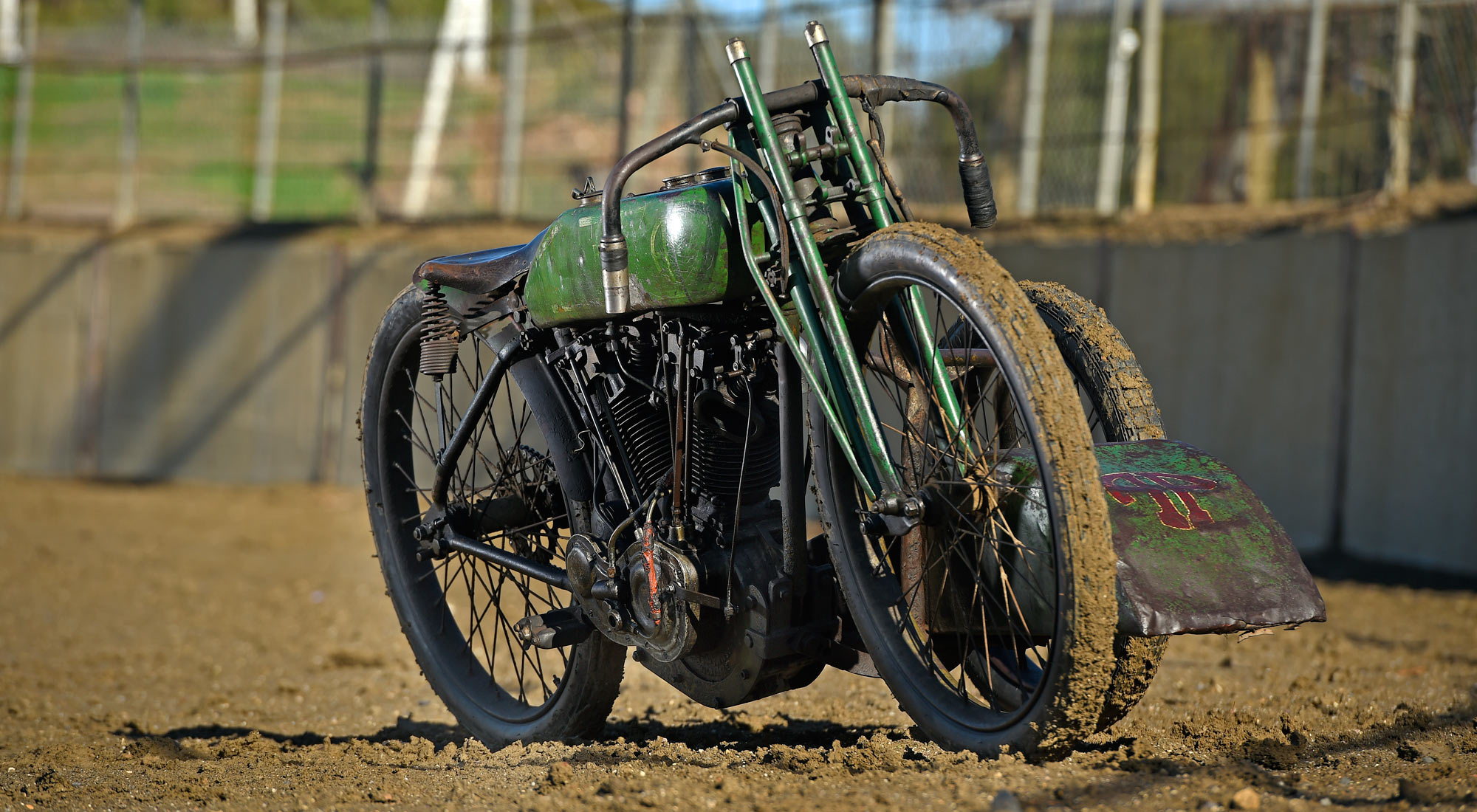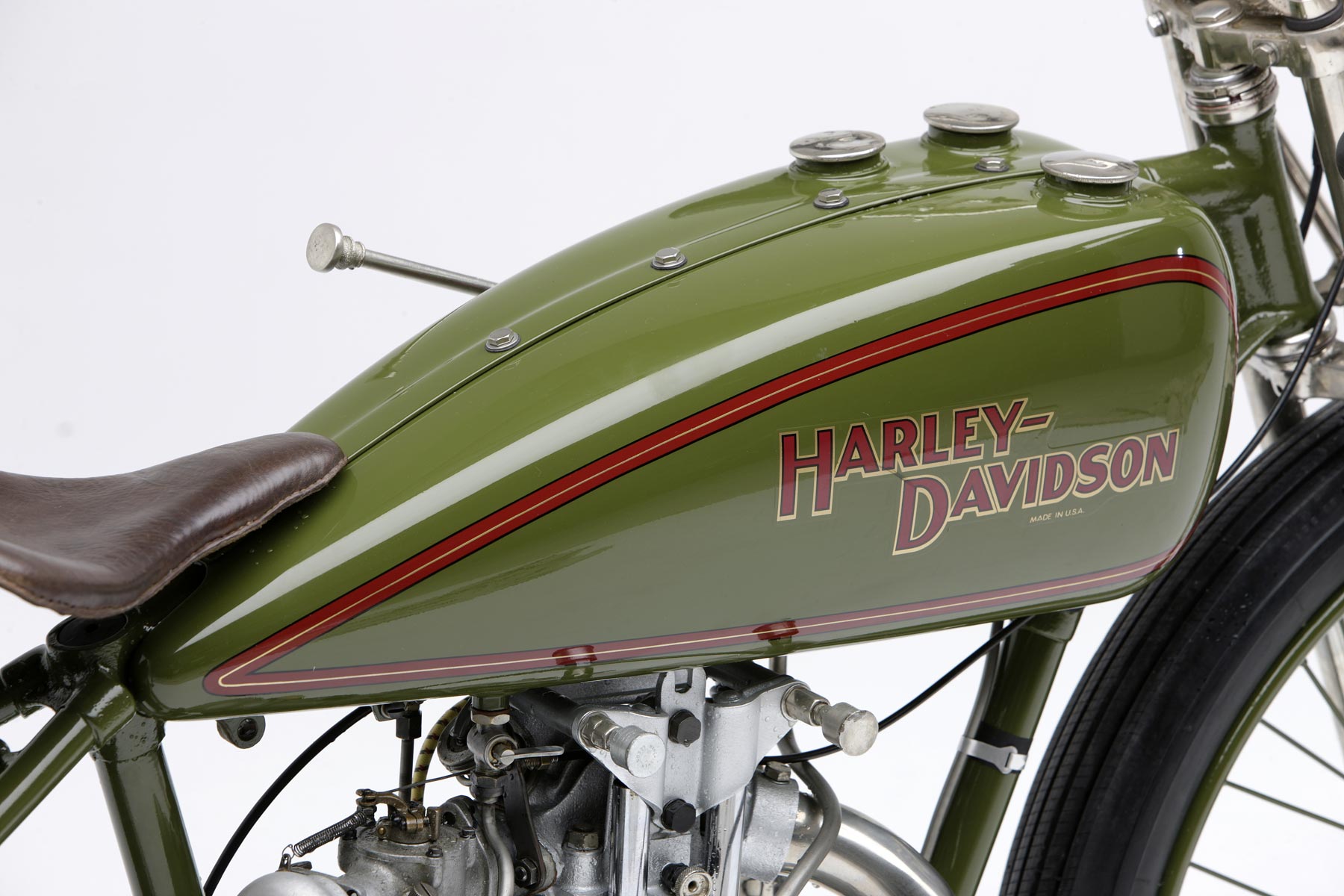
‘The Harley Eight Valve’
Harley-Davidson was considered a late comer to the racing scene particularly in the USA. It wasn’t until 1915 that Harley produced a model for racing, but in 1916 they certainly made up for that slow start. Racing engineer Bill Ottoway and Bill Harley leaned on aeronautical knowledge to design a hemispherical OHV combustion chamber with 4 valves per cylinder of one piece design to go straight on to their regular type crankcase assembly. Using the normal for the period countershaft drive with no clutch, transmission or brakes the 230 pound racer looked like 100 mph standing still. Success was immediate with Irving Janke winning the prestigious Dodge City 300 mile race at an average speed of just under 80 mph and a time of 3 hours 45 minutes. Durability must have been excellent when one considers the temperature was 110 degrees.

Racing at this time was considered a major ingredient to a manufactures marketing program and Harley was quick to capitalise on this success and put together a team of riders that were to dominate American racing both board and dirt for the next 7 years. One notable result for the Eight Valve were Otto Walker winning a 25 mile race at Beverley Hills on April 24th 1921 at an average speed of nearly 105 mph. Another was Ralph Hepburn, was to win the final Dodge City 300 miler on the 4th of July 1921 at an average speed of 85:69 mph. This result again confirmed the durability of these machines.

In 1922 Harley withdrew it’s fully sponsored racing team, but continued development of racing models for support to individual riders and also to send to its many export markets including Australia, England, Germany, Italy and New Zealand. It would be these countries that would write the next chapter of Harley racing history. The Eight Valve had been updated in 1919 to a second version cylinder featuring refinements on the 1916 version, as well as a two cam arrangement in the gear case permitting higher engine revolutions. In 1923 came the third version of cylinder with extra-large exhaust ports cast into the still one piece, cylinder construction. These were coupled with a new two cam gear case arrangement that had direct drive to roller tappets that enhanced high speed running even further. These machines to this time had been completed with the short countershaft type racing frame, direct drive and no brakes. They were generally exported in this form also. This configuration was not appropriate in several markets where clutches, transmissions and brake were all components required for various types of road racing in particular.

This situation saw many of the Eight Valves exported, removed from these frames and fitted in modified Harley road bike frames with the regular 3 speed transmission and clutch. Harley built their last batch of countershaft Eight Valve racers in 1927. By then circuit racing in the USA had been confined to machines of 350cc and hill climbers to 750cc. The Harley racing department was to build machines that would dominate these classes in time to come. The final 1927 Eight Valves were put into storage to be given to favoured overseas dealers in the early 1930’s, where positive results were still forth coming.



Where did they go?
The first eight valves Harley produced went to factory team members where they were particularly successful, specially at the Dodge City 300 mile race, but also wins were recorded in 1916 at Sheepshead Bay New York, Le Grande Oregon and Detroit Michigan.

As was the pattern in following years, all Eight Valves in the USA were raced by factory riders. When they were plain worn out they went to the scrapheap. There are no records or evidence of any US Eight Valves being sold to anyone. Export markets were a different situation. It is documented that the Jones brothers in New Zealand received one of early single cam versions. By the early 1920’s, Australia, England, Italy, Germany and New Zealand were all to receive the newer two cam variants. Percy Coleman was to win consecutive New Zealand Grass Track championships in 1922, 1923 and 1924. In Australia the engines were popular for sidecar racers.

By later in the twenties with the factory still controlling domestic race bikes, the last of the Eight Valve Two Cams went to export markets as late as 1932. Scandinavia was a fertile area for Eight Valves with many victories and speed records.

Where are they now?
Because of the Eight Valves great performance record and purebred appearance they have been sought after by collectors for many decades. This has led to about 20 replicas being built with various degrees of accuracy. Any authentic machines, or parts of, had to be sourced of course from the various export markets that Harley sent these bikes too. To date no single cam bikes are known to exist, but one cylinder was found in New Zealand. An almost complete engine, frame and forks were found in New Zealand and shipped to the USA in the late eighties. In Australia, an indirect action two cam version was discovered and restored by Bill McNamara. This bike is now in the USA. Both a Banjo Two Cam and another indirect action reside in Italy. They are in modified road frames with transmissions. Maybe the best known Banjo version that went to England and was successfully raced by Freddie Dixon. It was immediately fitted into a road frame with transmission. In the early seventies it was purchased by Californian John Cameron who used the bike regularly on club events. It went on to be owned by collector Daniel Statnekov, who sold it to Harley, who have it as a feature display in their Milwaukee Museum.

The latest find was our feature bike, 27FHA81, which arrived in Melbourne during 1932. After long term custodianship by Bob Bennell (His father Robert raced the bike as late as 1941 at Aspendale where he was placed third) the bike went to auction in 2015. It resides in the Harley City Collection. This bike has its original factory racing components. Engine, short track countershaft frame, forks, large racing tanks and wheels.

Recommissioning 27FHA81
When 27FHA81 came into our possession, it had been in storage for some 70 years. The bike had spent most of its racing life on the rough country tracks of Warrigal, Werribee and at Melbourne’s Aspendale Speedway. The Smith Brothers, Rothie and Diggar, as well as their brother in-law, Robert Bennell, all piloted or ran passenger at the various meetings, maybe the last being at Aspendale in 1941. Robert Bennell kept the bike in storage from that date on, passing custodianship to his son Robert Junior.

This meant that we were recommissioning a machine that had been retired while it had been still running. We wanted to conserve and preserve it in running condition without total restoration. Firstly, we removed the wheels and used a hacksaw to cut off tyres that were rock hard. With new tyres and tubes fitted, inflated to the regulation 50 psi, we had a machine that was now easy to move about. We then gave the complete motorcycle inside and out a thorough dunking in Kroil, a rust inhibitor and lubricator as well as a general detailer all in one can. The engine appeared to be seized but after much effort we were able to gradually free it and eventually were able to turn it over at a reasonable rate.

The spark had long left our magneto so removal meant the cam cover had to be parted from crankcases it had been joined to for 75 years. Inspection of the gear case showed cams and followers in excellent condition. With magneto rebuilt and the engine reassembled attention was given to the carburettor and control cables. New chains were installed. Carburettor was removed, cleaned; a new float and float needle were fitted. Then it was time to see if we were to receive reward for our labour. Reward we certainly received with a healthy bark from the open exhaust ports as well as 18 inch blue flames putting on a superb light show. Mission accomplished.


Period photos of 27FHA81
Here are some period photos of 27FHA81 that we have discovered





Words:
David Reidie
Photos:
Ben McIntyre (body)
TBA (header)
Period photos unknown

































































































































